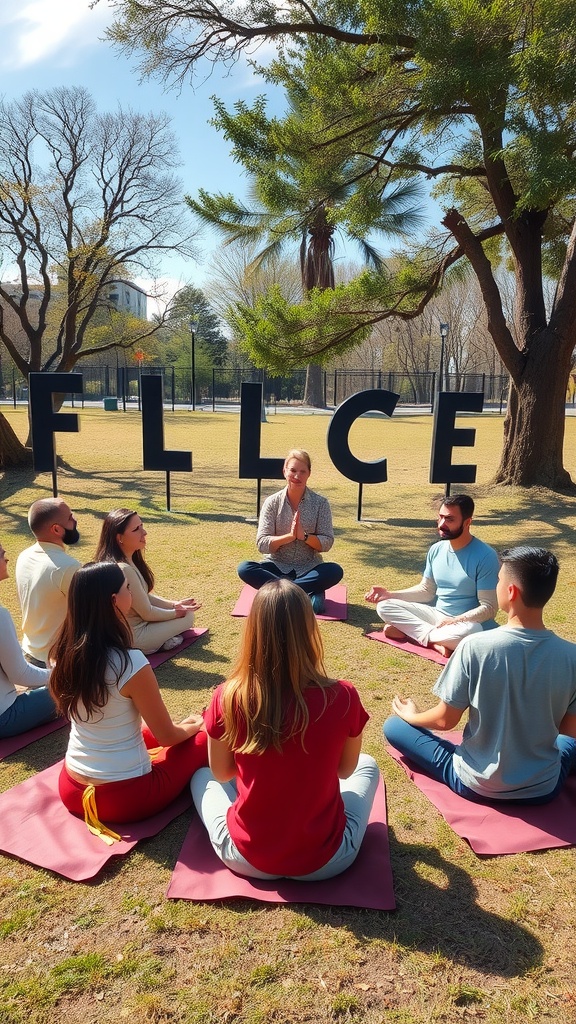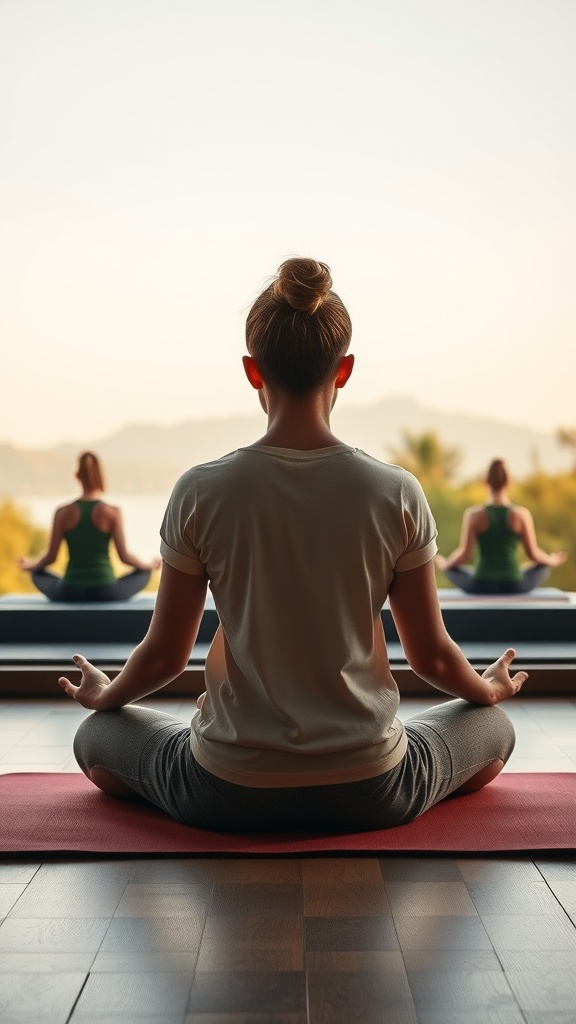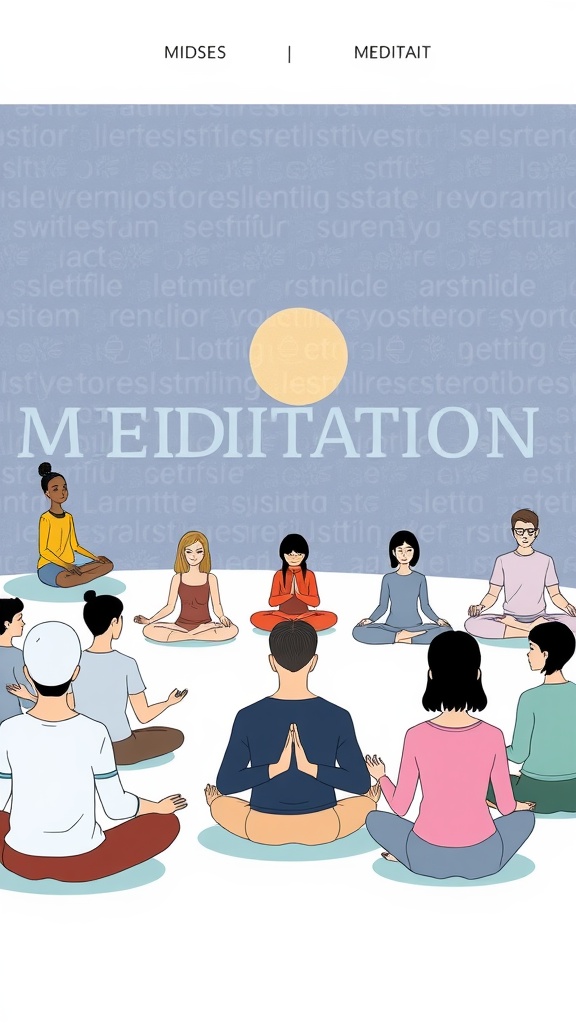10 Essential Steps to Start Your Meditation Routine
If you’re looking to incorporate a meditation routine into your life, you’re in the right place. Starting doesn’t have to be daunting! Just a few simple steps and a little bit of patience can set you on your way to building a peaceful practice. We’ll guide you through the basics to help you find your calm, whether you’ve got five minutes or an hour to spare.
Finding a Meditation Community or Group

Joining a meditation community can be a lovely way to enhance your practice. In the image, you can see a group of people sitting together in a serene outdoor setting, gathering for a meditation session. The bright sun and natural surroundings create a peaceful atmosphere, perfect for focusing inward.
Being part of a group offers support and motivation. Whether you’re a beginner or someone with more experience, sharing moments with others who have similar interests can make the journey more enjoyable. Look for local groups in parks, community centers, or even online.
A community can help you stay committed to your routine. Many groups will host regular meet-ups, which can keep you inspired and accountable. Plus, learning from others can introduce you to new techniques and perspectives.
Don’t hesitate to try different groups until you find one that feels right. Some might focus on a specific style, while others may be more laid-back. The key is to find a community where you feel comfortable and connected.
Creating a Calm Space for Meditation

Setting up a peaceful spot for meditation can transform your practice. Imagine a room with soft lighting, comfortable cushions, and a few plants. This serene setting invites relaxation and focus.
The image shows a beautiful space filled with light and natural elements. Cushions on the floor promise comfort, while candles offer a gentle glow. The greenery adds a refreshing touch to the environment, creating a connection with nature.
To create your own calm space, start with a clean area. Choose a spot that feels cozy and quiet. Arrange cushions where you can sit comfortably, ensuring you have enough room to stretch out if needed. Adding calming colors and textures can enhance the vibe.
Don’t forget about the sound and smell. A few candles or essential oils can make a big difference. Consider playing soft music or nature sounds to help you unwind. Remember, the goal is to create a space that feels inviting and tranquil.
With the right setup, you’ll find it easier to focus on your breathing and thoughts. Take your time to design your meditation space so it truly reflects your personal style and needs.
Using Apps and Resources to Enhance Practice

In today’s world, using technology to support your meditation journey is easier than ever. The image shows a phone displaying a meditation app, which highlights how accessible these resources can be. With just a few taps, you can dive into guided sessions, calming sounds, and helpful tips.
Apps are designed to cater to various needs, whether you’re a beginner or someone with more experience. They often include features like progress tracking, reminders, and even community support. This can make your meditation practice feel more engaging and less daunting.
Consider exploring different apps to find one that resonates with you. Some offer specific themes, such as mindfulness or stress relief, while others focus on sleep or self-compassion. The key is to experiment until you find a routine that suits your lifestyle.
In addition to apps, online resources like podcasts and videos can broaden your understanding of meditation techniques. This way, you can learn from experts and integrate their insights into your practice. The combination of technology and mindfulness can lead to a more fulfilling meditation experience.
Selecting a Comfortable Meditation Position

Finding a comfortable position is key to starting your meditation routine. In the image, you can see several individuals sitting in a serene environment, each focused and calm. The setting highlights the importance of a peaceful space for meditation. Being comfortable helps to maintain focus and avoid distractions.
When choosing your position, consider sitting cross-legged on a mat as shown in the image. This posture can help keep your spine straight while allowing your body to relax. If that’s not comfortable, feel free to sit on a chair or even lie down. The goal is to find a position that feels natural for you.
Pay attention to your body. If you start to feel any discomfort, adjust your position. You might also want to place cushions under your knees or lower back for extra support. The focus is on comfort so that you can concentrate fully on your breath and thoughts.
Exploring Different Meditation Styles

The image above captures a diverse group of individuals engaged in meditation. Each person sits comfortably, reflecting a sense of calm and focus. This scene illustrates the inclusivity of meditation, showing that anyone can benefit from this practice, regardless of their background.
When starting a meditation routine, exploring different styles is key. You might find that one type resonates more than others. For instance, some prefer mindfulness meditation, where you focus on your breath and the present moment. It’s simple and can be done anywhere.
Others might enjoy loving-kindness meditation, which emphasizes compassion and connection. The practice encourages sending goodwill to yourself and others, fostering a sense of community.
For those who appreciate structure, guided meditation can be very helpful. Guided sessions often involve an instructor or a recording leading you through the process, making it easier for beginners to stay focused.
As you explore, remember that there’s no right or wrong way to meditate. What matters is finding what feels comfortable for you. Experiment with different styles and see what works best in your daily routine.
Incorporating Breathing Techniques

Breathing techniques play a crucial role in meditation. They help ground you and can enhance your focus. When starting a meditation routine, it’s essential to integrate simple breathing exercises. These exercises not only calm your mind but also prepare your body for deeper relaxation.
Imagine sitting comfortably, just like the person in the image. With headphones on, they might be immersed in soothing sounds or guided meditations. This setting creates a peaceful atmosphere for mindfulness. Focusing on your breath, inhale deeply through your nose and exhale slowly through your mouth. This technique helps clear your mind of distractions.
Another effective method is the 4-7-8 technique. Breathe in for a count of four, hold for seven, and exhale for eight. This helps slow your heart rate and induces a tranquil state. Practice this routine regularly, and you’ll likely notice an increase in your overall sense of calm.
Remember, consistency is key. Setting aside a few minutes each day to practice these breathing techniques will enhance your meditation experience. Whether you’re at home or in a quiet space, finding that moment for yourself can make all the difference.
Setting Realistic Goals for Your Routine

Starting a meditation routine can feel overwhelming, but it doesn’t have to be. The image shows a cozy setting with a notebook open to a page titled ‘Meditation Goals.’ This visual emphasizes the importance of setting clear and manageable objectives for your practice.
When creating goals, think about what you want to achieve. The notebook lists various goals like ‘Breathe deeply’ and ‘Feel grounded.’ These simple, actionable items help you focus on specific aspects of your meditation journey.
It’s essential to start small. If you’re new to meditation, commit to just a few minutes each day. Gradually increase your time as you become more comfortable. Remember, consistency is key. Making meditation a part of your daily routine will help you integrate it into your life.
Consider writing your goals down, just like in the image. This makes them tangible and keeps you accountable. You can even decorate the page with encouraging quotes or doodles. The act of writing can be a meditative experience in itself!
Lastly, be kind to yourself. Some days will be easier than others. If you miss a session, don’t stress. Just pick back up where you left off. Setting realistic goals helps you stay motivated and enjoy the process.
Choosing the Right Time for Daily Practice

Finding the right time to meditate can make a big difference in your practice. The image shows a person meditating at sunset, a time often considered peaceful and reflective. This serene setting highlights how the world around you can enhance your meditation experience.
Many people find that early mornings work best for them. The quiet of the morning can help you start the day with a calm mindset. On the other hand, if mornings are too hectic, you might prefer to meditate in the evening. This can help you unwind after a busy day.
Each time of day offers its own benefits. For instance, meditating at sunset, as shown in the image, allows you to connect with nature and appreciate the beauty around you. The fading light can create an inviting atmosphere that encourages relaxation.
Experiment with different times to see what feels right for you. Consistency is key, so try to stick to a time that fits into your daily routine. Over time, you’ll find that this dedicated practice can help you develop a deeper sense of mindfulness.
Integrating Mindfulness into Daily Life

Imagine stepping outside, surrounded by nature, just like the person in the image. This scene captures a peaceful moment, where a young person walks slowly, taking in their surroundings. It’s a perfect reminder of how simple it can be to integrate mindfulness into our daily routines.
Mindfulness is all about being present and aware of your thoughts and feelings. You can start with small steps. For instance, during your daily walk, focus on your breath and the feeling of the ground beneath your feet. Notice the plants around you, just like the greenery in the illustration.
Another way to integrate mindfulness is by setting aside a few minutes each day for meditation. Find a quiet spot, sit comfortably, and let your thoughts flow without judgment. This can help clear your mind and improve your focus, making it easier to stay present throughout the day.
Remember, it’s about progress, not perfection. Each small effort counts. So, whether you’re walking, meditating, or just enjoying a quiet moment, embrace the journey of mindfulness.
Tracking Your Progress Over Time
![]()
When starting a meditation routine, tracking your progress can be really helpful. The image shows a cozy setup with a journal open to a page labeled ‘Progress.’ It features a simple chart that allows you to jot down your meditation sessions, making it easier to see how you’re doing over time.
Having a dedicated space for reflection, like the one shown, can make your practice feel more intentional. The natural light pouring in from the window and the peaceful surroundings help set the mood for mindfulness. You can easily get inspired to meditate when your environment is inviting.
Writing in your journal after each session is a great way to note how you felt. Did you manage to focus? Were there distractions? The chart in the image reminds you of the importance of consistency. You can mark each day you meditate, allowing you to visualize your commitment.
As you track your journey, you may notice patterns or trends. Maybe weekends are harder to find time, or perhaps you feel more relaxed after a morning session. This insight can guide your future meditations. By keeping your journal close, you’re creating a ritual that fosters growth.